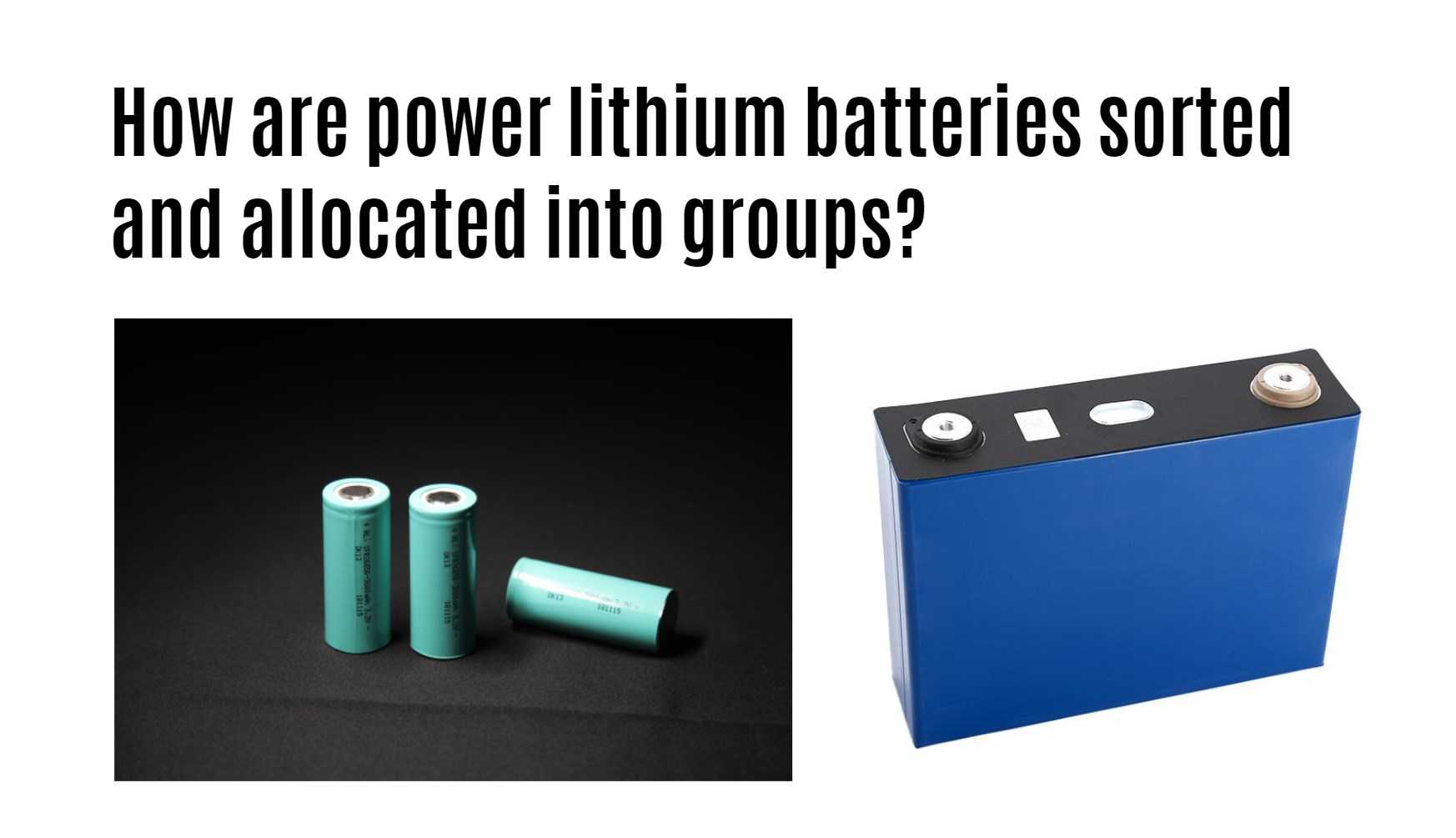Power lithium batteries are the unsung heroes that power our devices, from smartphones to electric vehicles. But have you ever wondered how these batteries are sorted and allocated into groups? Let’s dive into the world of power lithium batteries and unravel the importance of sorting and allocation methods for these energy powerhouses.
Why Sorting and Allocation is Important for Power Lithium Batteries
Sorting and allocating power lithium batteries may seem like a mundane task, but it plays a crucial role in maximizing their efficiency and lifespan. By categorizing batteries based on factors like voltage, capacity, and internal resistance, we ensure that they are used in compatible groups.
Proper sorting helps create balanced battery packs that perform optimally, preventing issues such as overcharging or uneven discharging. This not only enhances the overall performance of the battery system but also promotes safety by reducing the risk of malfunctions.
Moreover, considering factors like age and usage pattern when allocating batteries ensures equal wear and tear among cells within a group. This balance extends the longevity of the entire battery pack while minimizing potential degradation.
In essence, sorting and allocating power lithium batteries is more than just an organizational task; it’s a strategic approach to enhancing efficiency, extending lifespan, and ensuring safe operation.
The Different Types of Sorting Methods:
When it comes to power lithium batteries, sorting and allocating them into groups is a crucial process. There are several methods used for sorting these batteries based on different criteria.
Voltage sorting involves categorizing batteries based on their voltage output. This ensures that batteries with similar voltage levels are grouped together for optimal performance.
Capacity sorting focuses on matching batteries with similar capacity levels. This helps in creating balanced battery packs that can deliver consistent power output.
Internal resistance sorting is another method where batteries are sorted based on their internal resistance levels. Low internal resistance leads to better efficiency and longer battery life.
Each of these sorting methods plays a significant role in ensuring that power lithium batteries are allocated into groups that complement each other well, ultimately enhancing the overall performance and longevity of the battery pack.
– Voltage Sorting
When it comes to power lithium batteries, voltage sorting is a crucial step in ensuring optimal performance. This process involves grouping batteries based on their voltage levels to create balanced packs with consistent output.
Voltage sorting helps prevent issues like uneven discharging among cells, which can lead to reduced overall battery life and potential safety hazards.
By carefully matching batteries with similar voltage characteristics, manufacturers can improve the efficiency and longevity of battery packs used in various applications.
This sorting method allows for better management of power distribution within devices, ultimately enhancing performance and reliability.
– Capacity Sorting
Capacity sorting is a crucial step in the process of allocating power lithium batteries into groups. This method involves measuring and categorizing batteries based on their storage capacity, which directly impacts their performance and longevity.
By sorting batteries according to their capacity, manufacturers can ensure that each group consists of cells with similar energy storage capabilities. This helps maintain consistent performance levels across different battery packs, leading to more reliable and efficient power delivery.
Capacity sorting allows for better matching of batteries within a group, reducing the risk of imbalances that can lead to uneven discharge rates or premature cell degradation. It also enables users to maximize the overall capacity and lifespan of their battery systems by utilizing cells with compatible energy storage characteristics.
Capacity sorting plays a vital role in optimizing the functionality and longevity of power lithium batteries in various applications.
– Internal Resistance Sorting
When it comes to power lithium batteries, internal resistance sorting plays a crucial role in ensuring optimal performance. Internal resistance refers to the opposition that electrical current faces within the battery itself. By sorting batteries based on their internal resistance levels, manufacturers can create groups of batteries with similar characteristics.
This sorting method helps ensure that batteries with similar internal resistance are used together in applications, preventing mismatched pairs that could lead to inefficiencies or even damage. Batteries with lower internal resistance tend to be more efficient and have better overall performance.
Internal resistance sorting allows for better utilization of each battery’s potential, maximizing energy output and prolonging battery life. It also contributes to safer operation by reducing the risk of overheating or other issues caused by imbalanced cells.
In essence, internal resistance sorting is a vital step in optimizing the performance and longevity of power lithium batteries across various applications and industries.
Factors Affecting Battery Group Allocation:
When it comes to sorting and allocating power lithium batteries, several factors come into play. One crucial aspect is the age of the battery. Older batteries tend to have different performance characteristics compared to newer ones. This can impact how they are grouped together for optimal efficiency.
Another factor that influences battery group allocation is the usage pattern. Batteries that have been subjected to high-demand applications may exhibit varying levels of capacity and internal resistance. Understanding how each battery has been utilized helps in creating well-balanced groups.
Considering these factors ensures that batteries with similar attributes are grouped together, leading to better overall performance and longevity of the energy storage system. Properly sorted and allocated batteries not only enhance efficiency but also contribute to a more reliable power supply for various applications.
– Age of the Battery
When it comes to sorting and allocating power lithium batteries, the age of the battery plays a significant role in determining its performance. Older batteries tend to have reduced capacity and may not hold a charge as well as newer ones. This can impact the overall efficiency of a battery system.
As batteries age, their internal resistance may increase, leading to slower charging times and decreased overall lifespan. This is why it’s crucial to take into account the age of each battery when grouping them for optimal performance.
By considering the age of the battery during sorting and allocation processes, you can ensure that each group is balanced in terms of performance and longevity. This helps maximize the overall effectiveness of your battery system and ensures consistent power output over time.
– Usage Pattern
Understanding the usage pattern of power lithium batteries plays a crucial role in their sorting and allocation. Different devices and applications demand varied levels of battery performance, which can impact how efficiently the batteries are utilized.
Devices that require high power output will need batteries with lower internal resistance to deliver consistent performance. On the other hand, devices that have long operating hours may benefit from capacity-sorted batteries to ensure extended usage without frequent recharging.
Moreover, considering whether the device has intermittent or continuous usage can influence how batteries are allocated into groups. Batteries used in applications with sporadic bursts of energy consumption may require different sorting criteria compared to those used in devices with constant power needs.
By analyzing these patterns carefully, manufacturers and users can optimize battery performance and lifespan based on specific operational requirements.
Benefits of Properly Sorted and Allocated Batteries
Properly sorted and allocated power lithium batteries offer numerous benefits to users and manufacturers alike. Having batteries grouped based on voltage, capacity, and internal resistance allows for efficient utilization of energy storage systems. This ensures that each battery in a group performs at its optimal level, maximizing overall performance.
Additionally, sorting batteries helps extend their lifespan by preventing over-discharge or overcharging issues that can lead to premature degradation. By matching batteries with similar characteristics in the same group, the risk of imbalance during charging or discharging is minimized, enhancing safety.
Moreover, properly sorted and allocated batteries contribute to improved system reliability and stability. Consistent performance across all battery groups means smoother operation of devices or equipment powered by these batteries.
Investing time in sorting and allocating power lithium batteries pays off through enhanced efficiency, longevity, safety measures achieved in energy storage solutions.
Challenges in Sorting and Allocating Power Lithium Batteries
Sorting and allocating power lithium batteries come with their own set of challenges. One common obstacle is the varying quality of batteries from different manufacturers, which can affect the sorting process. Additionally, inconsistencies in battery performance over time due to factors like aging or usage patterns can complicate accurate allocation into groups.
Another challenge lies in the precision required for sorting methods such as voltage, capacity, and internal resistance. Even minor discrepancies in measurements can result in inaccurate groupings that may impact overall battery performance.
Furthermore, limited resources and time constraints can hinder efficient sorting and allocation processes, especially when dealing with large quantities of batteries. Ensuring consistent standards across all batches also presents a challenge to maintain uniformity within each group.
Despite these hurdles, advancements in technology continue to address these challenges by introducing more sophisticated tools and algorithms for improved accuracy in sorting and allocating power lithium batteries.

Conclusion
Sorting and allocating power lithium batteries is a crucial process that ensures optimal performance and longevity. By categorizing batteries based on voltage, capacity, and internal resistance, manufacturers can create balanced groups for various applications. Factors like age and usage patterns further influence how batteries are grouped to maximize efficiency.
Properly sorted and allocated batteries offer enhanced reliability, improved safety, and increased overall performance in battery packs. Despite the challenges involved in sorting lithium batteries accurately, the benefits far outweigh the difficulties. Manufacturers must continue to refine their sorting processes to meet the increasing demand for high-quality power sources.
Meticulous attention to detail in sorting and allocating power lithium batteries not only enhances device functionality but also contributes significantly to sustainability efforts by extending battery life cycles. This essential step ultimately leads to better energy storage solutions for a variety of industries worldwide.




